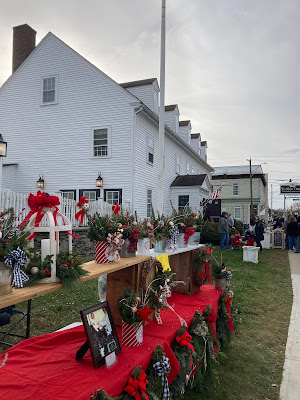Brookfield, Massachusetts - "Staid At Night"
There was and is more to Brookfield, Massachusetts, than the murder of Joshua Spooner. That includes the displacement of its Native inhabitants a century earlier by 17th century European settlers, the coming and going of the Convention Army along its post road and past its milestones, and a story of "what might have been". My own travel along the route of march of the Convention Army in 1777 has led to further exploration of the town (now four towns), including West Brookfield's "Asparagus, Flower and Heritage Festival" in May, and winter festival seen below outside what was tavern in 1777 and recently re-opened as the Hitchcock Tavern, a place for lunch or dinner, and drinks.
The first troops of the Convention Army to arrive in Brookfield were from the British column. Massachusetts Militia Private David How, one of their guards, wrote that on October 31st: "This Day we marchd to Brookfield Staid at Night." How and others would spend a second night in Brookfield. "This Day we have Ben waiting for the prisoners all to Get together & Draw provisions" How noted on November 1st, and then, on 2nd: "This morning we Set off. marchd through Spenser & Lester". [1]
British Lieutenant (Lord) Francis Napier, of the 31st Regiment of Foot, recorded likewise, "October 31. Brookfield - 12 Mi[les]"; "November 1st Halt"; and on November 2nd, a march of 18 miles to Worcester. [2]
As British troops left, German troops arrived. They were not particularly welcome. "The 2d, our march was through West-town ["Western" which became Warren, Massachusetts in 1834] ... to Brookfield, fifteen miles. The inhabitants would not receive us into their houses; they maintained that neither Congress, nor General Gates, nor Colonel Reid, who commanded our escort, could ask that of them." Brunswicker Grenadier Johann Bense noted only "in the woods" for November 2nd, as he had for the 1st and would for the 3rd. [3]
It was from here that the Convention Army's British and German columns would continue on a common route across Worcester County and on to Cambridge and Charlestown, after following separate paths through New York, across the Berkshires and over the Connecticut River for two weeks prior. "The Engl. corps crossed us today on our march" notes the Specht Journal, "and from now on had to march on the same road to Boston with us." Though committed to staying a day apart, trailing elements of the British column stayed somewhere in Brookfield the night of the 2nd as well, the journal of an officer of the 47th Regiment of Foot noting their arrival there from Belchertown after a march of 18 miles. [4]
The following day Lieutenant-General John Burgoyne arrived and spent the night, before traveling on through Worcester, where he encountered Major-General Friedrich Riedesel and the German column on November 4th.
One year later the Convention Army would pass through Brookfield again. Still captives, and now on their way to Virginia, British troops from the 47th Regiment would spend the night somewhere in town on November 12, 1778, as would Germans on November 14 and 15, 1778. [5]
The coming and going of the Convention Army highlight Brookfield's location in the 18th century that was several days marching from Boston Harbor, at a place on the road where traveling westward a right at the fork led to the Albany, the Hudson River and Champlain Valley, and a left to Connecticut, New York City and the middle and southern states. Washington knew of the town, having passed through on July 1, 1775, in route to his taking command of the Continental Army.
Due to its location, Brookfield was proposed as the site of an armory to safely hold and repair the arms of the Continental Army. Chief among its proponents was Colonel Jeduthan Baldwin, an engineer with the Northern Department responsible for designing the defensive works at Mount Independence, Vermont in 1776, construction of the army's bridge of logs at Saratoga, and a resident of Brookfield. In August of 1777, as New England militia joined the Northern Army to stop Burgoyne's invasion from Canada, nearly 200 barrels of gunpowder and 83 chests of arms were stored at Brookfield.
Ultimately Springfield was chosen over Brookfield, on the recommendation of Brigadier-General Henry Knox, who had passed through both towns in route to Boston with the cannon taken at Fort Ticonderoga and in the Champlain Valley in 1775. Springfield was preferable he argued, given its location on the Connecticut River, its better access to water power for the operation of mills, and the availably of timber for construction and provisions to feed the workers it would employ. [6] As the Springfield Armory, today a National Historic Site, that city, and not Brookfield, would be the site of much of the United States' small arms development and production for two centuries - and it too was along the route of march of the Convention Army.




Comments
Post a Comment